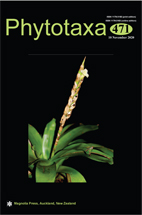Abstract
A new species of Vicoa, V. gokhalei is described and illustrated from high elevated areas of northern Western Ghats, India. The new species is closely related with V. cernua which is also known from high elevated areas of northern Western Ghats. Along with detailed description, diagnostic characters, phenology, coloured photographs, illustration, ecological note, distribution and identity of the new species and key of Vicoa species for India are provided.
References
<p class="Reference">Cassini, H. (1818) Aperçu des Genres nouveaux formés par M. Henri Cassini dans la famille des Synanthérées<em>. Bulletin des Sciences, par la Societe Philomatique, Paris</em> 1818: 73–77.</p><p class="Reference">Cassini, H. (1829) Tableau Synoptique Des Synantherees. <em>Annales des Sciences Naturelles, Paris</em> 17: 387–423.</p><p class="Reference">Cooke, T. (1908) <em>The Flora of the Presidency of Bombay, </em>vol. 2. Taylor & Francis, London, 1083 pp.</p><p class="Reference">Dalzell, N.A. & Gibson, A. (1861) <em>The Bombay Flora</em>. Education Society’s Press, Bombay, 126 pp.</p><p class="Reference">Gutierrez-Larruscain, D., Vicente, M.S., Anderberg, A.A., Rico, E. & Martínez-Ortega, M.M. (2018) Phylogeny of the <em>Inula</em> group (Asteraceae: Inuleae): Evidence from nuclear and plastid genomes and a recircumscription of <em>Pentanema. Taxon</em> 67 (1): 149–164.</p><p class="Reference"> <a href="https://doi.org/10.12705/671.10">https://doi.org/10.12705/671.10</a></p><p class="Reference">Hajra, P.K., Rao, R.R., Singh, D.K. & Uniyal, D.K. (1995) <em>Flora of India</em>, vol. 13. Botanical Survey of India, Calcutta, 28 pp.</p><p class="Reference">IUCN (2012) <em>IUCN Red List Categories and Criteria</em>: Version 3.1. Second Edition. IUCN, Species Survival Commission, Gland. [http://www.iucnredlist.org]</p><p class="Reference">Linnaeus, C. (1753) <em>Species Plantarum</em>. Laurentius Salvius, Stockholm, 881pp.</p><p class="Reference">Mabberley, D.J. (2017)<em> Mabberley’s Plant-Book: A portable dictionary of plants, their classification and uses</em>, 4th ed. Cambridge University Press, Cambridge, 693 pp.</p><p class="Reference"> <a href="https://doi.org/10.1017/9781316335581">https://doi.org/10.1017/9781316335581</a></p><p class="Reference">Nayar, T.S., Rasiya, B.A. & Sibi, M. (2014) <em>Flowering plants of the Western Ghats of India</em>, vol 1. Jawaharlal Nehru Tropical Botanical Garden & Research Institute, Thiruvaanathapuram, Kerala, India, 171 pp.</p><p class="Reference">POWO (2019) <em>Plants of the World Online</em>. Facilitated by the Royal Botanic Gardens, Kew. Available from: <a href="http://www.plantsoftheworldonline.org/">http://www.plantsoftheworldonline.org/</a> (accessed 21 September 2020)</p><p class="Reference">Raju, R.R.V. & Raju, C.P. (1996) A new variety of <em>Pentanema indicum</em> (L.) Ling (Asteraceae) from Andhra Pradesh, India. <em>Rheedea</em> 6: 55–58.</p><p class="Reference">Saxena, H.O. & Brahman, M. (1995) <em>The Flora of Orissa</em>, vol. 2. Orissa Forest Development Corporation Ltd., Bhubhaneshwar, pp. 968–969.</p><p>Shetty, B.V. & Singh, V. (1987) <em>Flora of Rajasthan</em>, vol. 1. Botanical Survey of India, Calcutta, pp. 426–427.</p>

